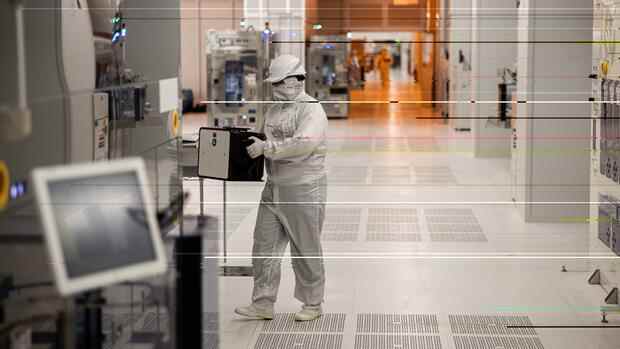Munich Excavators will soon be rolling again at Infineon: Germany’s largest chip manufacturer will build a new factory in Kulim in Malaysia for two billion euros. The Dax group announced this on Thursday morning. With the plant, the Munich-based company wants to achieve additional annual sales of two billion euros in the future.
So-called compound semiconductors made of the innovative materials silicon carbide (SiC) and gallium nitride (GaN) are to be produced at the existing site in Malaysia. These chips are in high demand for electromobility and also for powering consumer electronics.
“With the expansion of the SiC and GaN capacities, Infineon is preparing for the accelerated growth of the market for compound semiconductors,” said Chief Operating Officer Jochen Hanebeck. The manager is to take over the management of the group from Reinhard Ploss on April 1st. Hanebeck: “We are creating a profitable combination with the development competence center in Villach and the cost-efficient production of SiC and GaN power semiconductors in Kulim.”
Just last fall, Infineon opened a new plant in Villach, Austria. In order to achieve economies of scale, it was clear that the next plant would be built at one of the group’s three major locations, i.e. in Dresden, Villach or Kulim. The CEO had emphasized this several times. Construction work in Kulim is scheduled to start in June, and the plant is scheduled to run in the second half of 2024. According to Infineon, 900 jobs will be created.
Top jobs of the day
Find the best jobs now and
be notified by email.
Silicon carbide drives Infineon sales
SiC is one of Infineon’s major growth drivers. SiC allows vehicle manufacturers to either use smaller batteries or offer a longer range. Silicon carbide also enables a shorter charging time. The composite thus helps to solve some of the fundamental problems of electromobility. It’s worth the effort, even though the material costs at least twice as much to buy as conventional silicon. Infineon aims to increase its sales of SiC chips to $1 billion by 2025.
Great hopes are also pinned on GaN. “Mobile phones, tablets and notebooks can be charged much faster with GaN chips,” says Andreas Urschitz, head of Infineon’s Power & Sensor Systems division. Infineon is the world’s largest manufacturer of so-called power semiconductors for power supply.
>> Read here: Takeover of billions: Intel pushes conversion to contract manufacturer
The Munich-based company is expecting such large growth in the business with components made of GaN this year that customers will have to be prepared to wait. Gallium nitride is three times more expensive than silicon. But more and more often, the benefits outweigh the disadvantages. The crystalline material can conduct much higher voltages than silicon. Current flows faster through components, so electronic devices charge faster.
In addition, companies with GaN chips can offer significantly more compact and efficient power supplies. Infineon competitor ST Microelectronics estimates that chargers with GaN can be 40 percent smaller. Alternatively, the devices offer more power with the same size. In addition, manufacturers promise that chargers with GaN chips will last longer. This makes the expensive raw material competitive.
Infineon invests more than promised to investors
However, Infineon’s hands are tied to a certain extent when it comes to new works. The group has promised investors that it will only invest 13 percent of sales. This should make the Dax group significantly more profitable than before. In recent years, Infineon has spent up to 18 percent of its proceeds on new machines and factories.
The billion-dollar takeover of US competitor Cypress in spring 2020 also made Ploss palatable to its shareholders by announcing that the investment ratio was falling. Because many of the chips from the Silicon Valley company come from contract manufacturers.
Exactly those suppliers, the so-called foundries, have not been able to produce as much as Infineon and other semiconductor companies order for months. The hitherto attractive, capital-saving mix of own and third-party factories is therefore reaching its limits.
Chip factories are horrifically expensive, so analysts are listening carefully when it comes to Infineon’s future factory plans. The group will invest 1.6 billion euros in the most recently opened plant in Carinthia by the middle of the decade, which corresponds to 15 percent of sales in the past financial year.
Ploss has announced investments of 2.4 billion for the current year, half more than last year. The manager wants to expand the scarce capacities and become less dependent on the contract manufacturers.
Shareholders fear overcapacity
However, the high investments irritate investors. It should be borne in mind that the upswing in the cycle is always followed by a downturn, says fund manager Markus Golinski from Union Investment: “There must be no massive overcapacity that would fall on the company’s toes during a downturn.” When investing in the future come the right balance, the investor warns.
At the moment, however, Infineon is very dynamic: Sales in the current fiscal year, which ends on September 30, are expected to increase by almost a fifth to 13 billion euros and the operating margin to a record 21 percent.
In any case, the environment is favourable. The consulting firm McKinsey estimates that sales in the chip industry will increase by up to eight percent every year up to 2030. This means that industry revenues will double compared to last year. According to McKinsey, the business with autochips – Infineon’s biggest source of revenue – will grow even more strongly.
More: The red pencil’s revenge: Infineon pays a high price for its thriftiness
